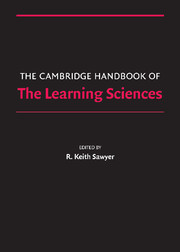Book contents
- Frontmatter
- Contents
- Preface
- Contributors
- 1 Introduction
- PART I FOUNDATIONS
- 2 Foundations and Opportunities for an Interdisciplinary Science of Learning
- 3 Constructionism
- 4 Cognitive Apprenticeship
- 5 Cognitive Tutors
- 6 Learning in Activity
- 7 Knowledge Building
- PART II METHODOLOGIES
- PART III THE NATURE OF KNOWLEDGE
- PART IV MAKING KNOWLEDGE VISIBLE
- PART V LEARNING TOGETHER
- PART VI LEARNING ENVIRONMENTS
- Afterword: After How Comes What
- Epilogue: The Fundamental Issue in the Learning Sciences
- Author Index
- Subject Index
- References
7 - Knowledge Building
Theory, Pedagogy, and Technology
Published online by Cambridge University Press: 05 June 2012
- Frontmatter
- Contents
- Preface
- Contributors
- 1 Introduction
- PART I FOUNDATIONS
- 2 Foundations and Opportunities for an Interdisciplinary Science of Learning
- 3 Constructionism
- 4 Cognitive Apprenticeship
- 5 Cognitive Tutors
- 6 Learning in Activity
- 7 Knowledge Building
- PART II METHODOLOGIES
- PART III THE NATURE OF KNOWLEDGE
- PART IV MAKING KNOWLEDGE VISIBLE
- PART V LEARNING TOGETHER
- PART VI LEARNING ENVIRONMENTS
- Afterword: After How Comes What
- Epilogue: The Fundamental Issue in the Learning Sciences
- Author Index
- Subject Index
- References
Summary
There are substantial similarities between deep learning and the processes by which knowledge advances in the disciplines. During the 1960s efforts to exploit these similarities gave rise to learning by discovery, guided discovery, inquiry learning, and Science: A Process Approach (American Association for the Advancement of Science, 1967). Since these initial reform efforts, scholars have learned a great deal about how knowledge advances. A mere listing of keywords suggests the significance and diversity of ideas that have come to prominence since the 1960s: Thomas Kuhn, Imre Lakatos, sociology of science, the “Science Wars,” social constructivism, schema theory, mental models, situated cognition, explanatory coherence, the “rhetorical turn,” communities of practice, memetics, connectionism, emergence, and self-organization. Educational approaches have changed in response to some of these developments; there is a greater emphasis on collaborative rather than individual inquiry, the tentative nature of empirical laws is more often noted, and argumentation has become an important part of some approaches. But the new “knowledge of knowledge” has much larger educational implications: Ours is a knowledge-creating civilization. A growing number of “knowledge societies” (Stehr, 1994), are joined in a deliberate effort to advance all the frontiers of knowledge. Sustained knowledge advancement is seen as essential for social progress of all kinds and for the solution of societal problems. From this standpoint the fundamental task of education is to enculturate youth into this knowledge-creating civilization and to help them find a place in it.
- Type
- Chapter
- Information
- The Cambridge Handbook of the Learning Sciences , pp. 97 - 116Publisher: Cambridge University PressPrint publication year: 2005
References
- 115
- Cited by



